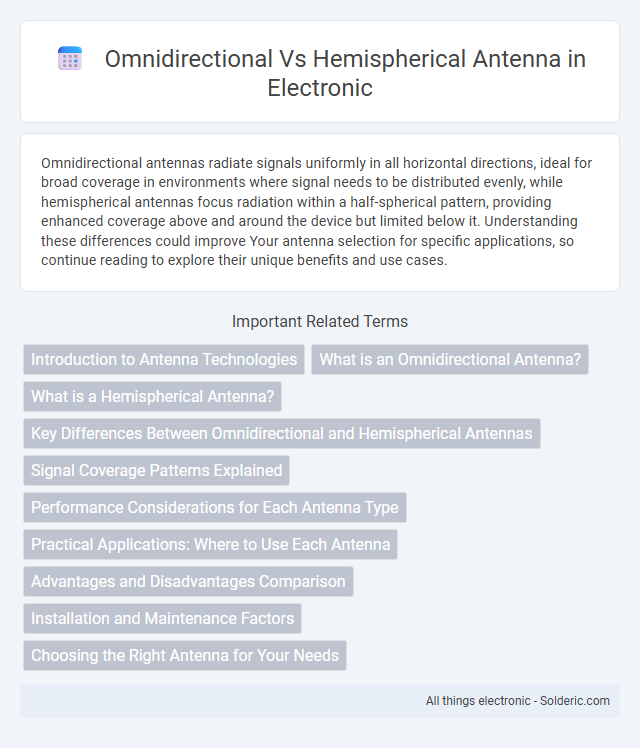Omnidirectional antennas radiate signals uniformly in all horizontal directions, ideal for broad coverage in environments where signal needs to be distributed evenly, while hemispherical antennas focus radiation within a half-spherical pattern, providing enhanced coverage above and around the device but limited below it. Understanding these differences could improve Your antenna selection for specific applications, so continue reading to explore their unique benefits and use cases.
Comparison Table
| Feature | Omnidirectional Antenna | Hemispherical Antenna |
|---|---|---|
| Coverage | 360deg horizontal, full circle | 180deg horizontal, half-circle |
| Radiation Pattern | Uniform horizontal, dipole-like vertical | Half-sphere, directional upward or outward |
| Use Cases | Wi-Fi, cellular base stations, general broadcasting | Surveillance, smart home devices, focused coverage |
| Gain | Typically 2-6 dBi | Usually higher gain within coverage hemisphere |
| Installation | Central location, vertical mounting | Mounted on ceilings or walls for directional focus |
| Interference | More susceptible due to omnidirectional pattern | Reduced interference with focused coverage |
Introduction to Antenna Technologies
Omnidirectional antennas radiate signals equally in all horizontal directions, making them ideal for broad coverage in wireless communication systems. Hemispherical antennas focus their radiation pattern over a half-sphere, offering enhanced performance for applications requiring coverage in a specific area, such as satellite or radar communications. Understanding these antenna technologies empowers you to select the optimal design based on coverage requirements and signal directionality.
What is an Omnidirectional Antenna?
An omnidirectional antenna radiates radio frequency signals uniformly in all horizontal directions, providing 360-degree coverage ideal for broad area communication. This antenna type is commonly used in applications requiring consistent signal reception or transmission around the antenna, such as in Wi-Fi routers, cellular base stations, and portable radios. If you need reliable coverage across multiple directions without signal loss, an omnidirectional antenna offers a versatile solution compared to directional or hemispherical antennas.
What is a Hemispherical Antenna?
A hemispherical antenna is designed to radiate or receive signals over a half-sphere, covering 180 degrees, which makes it ideal for applications requiring broad but downward-focused coverage, such as indoor Wi-Fi or certain radar systems. Unlike omnidirectional antennas that radiate uniformly in all directions on a horizontal plane, hemispherical antennas concentrate energy over a larger vertical angle, enhancing signal strength below and around the device. Understanding this distinction helps you choose the right antenna for maximizing signal quality in environments with multi-level or downward signal propagation needs.
Key Differences Between Omnidirectional and Hemispherical Antennas
Omnidirectional antennas transmit and receive signals uniformly in all horizontal directions, providing 360-degree coverage ideal for mobile and general-purpose applications. Hemispherical antennas emit signals over a half-sphere pattern, focusing energy upward and laterally, which enhances vertical coverage and is commonly used in satellite communications and indoor environments. Key differences include radiation pattern shape, coverage area, and application suitability, with omnidirectional antennas offering broad horizontal coverage while hemispherical antennas optimize signal distribution in three-dimensional spaces.
Signal Coverage Patterns Explained
Omnidirectional antennas provide 360-degree horizontal signal coverage, ideal for maintaining consistent connectivity in all directions around the antenna. Hemispherical antennas offer a wider vertical coverage up to 180 degrees, making them suitable for applications requiring strong signal reception from above or below, such as in multi-story buildings or drone communication. Understanding your environment and signal coverage needs ensures optimal antenna selection for reliable wireless performance.
Performance Considerations for Each Antenna Type
Omnidirectional antennas provide uniform 360-degree horizontal coverage, ideal for applications requiring consistent signal distribution in all directions but often exhibit limited range and potential interference in crowded environments. Hemispherical antennas concentrate signals within a 180-degree vertical or horizontal plane, offering enhanced gain and improved range over targeted areas while minimizing interference outside their coverage zone. Choosing between these antennas depends on the specific coverage area, desired signal strength, and environmental factors affecting signal propagation and quality.
Practical Applications: Where to Use Each Antenna
Omnidirectional antennas are ideal for environments requiring 360-degree coverage, such as wireless access points in offices, urban cellular networks, and outdoor Wi-Fi hotspots, where broad signal distribution is essential. Hemispherical antennas suit applications that demand wide coverage over a half-sphere, like satellite communication, drone control, and radio broadcasting, targeting signals above the ground plane without interference. Selecting between these antennas depends on coverage area requirements and signal propagation characteristics specific to indoor or outdoor settings.
Advantages and Disadvantages Comparison
Omnidirectional antennas offer 360-degree horizontal coverage, making them ideal for broad signal distribution but suffer from limited range and potential interference in dense environments. Hemispherical antennas provide more focused vertical and horizontal coverage, improving signal strength and reducing interference, yet their coverage area is restricted compared to omnidirectional types. Choosing between the two depends on application requirements such as coverage area, signal clarity, and environmental constraints.
Installation and Maintenance Factors
Omnidirectional antennas require minimal installation effort due to their uniform 360-degree signal distribution, making them ideal for environments where consistent coverage in all directions is needed. Hemispherical antennas demand precise positioning and alignment to optimize their half-spherical coverage, which can increase installation complexity and maintenance checks. Regular maintenance for hemispherical antennas involves ensuring correct orientation and clear signal paths, whereas omnidirectional antennas generally need less frequent adjustments due to their broader coverage pattern.
Choosing the Right Antenna for Your Needs
Choosing between an omnidirectional and hemispherical antenna depends on the desired signal coverage and environment. Omnidirectional antennas provide 360-degree horizontal coverage, ideal for evenly distributing signals in open, flat areas or urban settings. Hemispherical antennas offer wide vertical coverage, making them suitable for environments with multiple elevation angles, such as hilly terrain or multi-story buildings.
omnidirectional vs hemispherical antenna Infographic

 solderic.com
solderic.com